


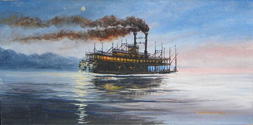
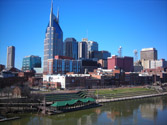
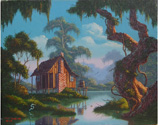
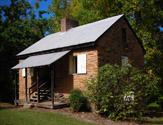









Cotton States Archive
The Ponce de Leon Apartments
One of Atlanta's Most Distinguished and Endangered Properties
One of Atlanta's Most Distinguished and Endangered Properties
The Ponce de Leon Apartments, located at the corner of Atlanta's famed Peachtree Street and Ponce de Leon Avenue, was the city's first luxury apartment building. Situated opposite the Georgian Terrace Hotel and Fox Theatre, the 12-floor building was completed in 1913, three quarters of a century before high-rise condominiums like Mayfair Renaissance, The Phoenix on Peachtree and Park Place (part-time home to singer Sir Elton John) graced the skylines of Atlanta's trendy Midtown and decidedly affluent Buckhead neighborhoods.
Incorporating Beaux-Arts and Renaissance Revival styles, famed architect William Lee Stoddart designed the Ponce de Leon Apartments to complement the Georgian Terrace Hotel. Featuring a gently curving front facade with a two-story columned colonnade, the building boasts a Tiffany glass dome in the lobby, possesses extensive terra cotta relief work and is easily recognized by its two prominent towers (which reportedly inspired Philip Johnson in his design of the modern 191 Peachtree Tower in downtown Atlanta).
In addition to the Ponce de Leon Apartments and Georgian Terrace Hotel, Stoddart was noted for designing Greenville's Poinsett Hotel, Charleston's Francis Marion Hotel, Winston-Salem's Nissen Building, Asheville's Battery Park Hotel and downtown Atlanta's Winecoff Hotel.
Through the years, the Ponce de Leon Apartments have stood in spite of Atlanta's ever-changing landscape. While renovations have been merited, some experts have insisted that projects intended to preserve and maintain the building have compromised its character. Others are even concerned that the building might be threatened.
In addition to the Ponce de Leon Apartments and Georgian Terrace Hotel, Stoddart was noted for designing Greenville's Poinsett Hotel, Charleston's Francis Marion Hotel, Winston-Salem's Nissen Building, Asheville's Battery Park Hotel and downtown Atlanta's Winecoff Hotel.
Through the years, the Ponce de Leon Apartments have stood in spite of Atlanta's ever-changing landscape. While renovations have been merited, some experts have insisted that projects intended to preserve and maintain the building have compromised its character. Others are even concerned that the building might be threatened.
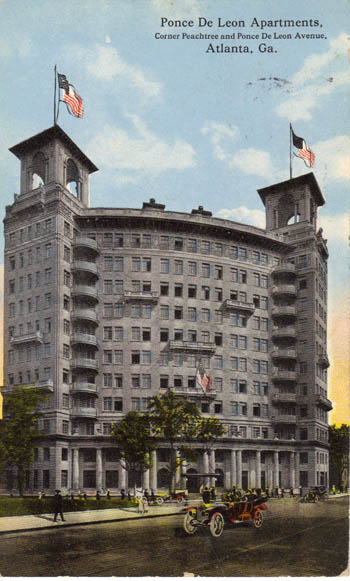
Writing for the New Georgia Encyclopedia, Robert M. Craig, professor emeritus of architectural history, at the Georgia Institute of Technology, described the Ponce de Leon Apartments in his entry, "Late Victorian Architecture: Overview," as "Atlanta's premier apartment building of the period." However, Craig adds, "At the Ponce de Leon Apartments, a regrettable decision to install exterior windows without mullions (that is, without shuttering or other vertical markers) during restoration in the 1980s provided the state its most dramatic illustration of what not to do in restoring a landmark building."
Further, the Georgia Trust for Historic Preservation released in 2005 its first "10 Places in Peril" list which included the Ponce de Leon Apartments. "After an incomplete condominium conversion in 1982, the building's fate is up in the air," the Georgia Trust stated. "The building needs substantial funding for rehabilitation. Many historic condominiums face similar problems in the future."
In a city where important landmarks have faced the wrecking ball, the fate of the Ponce de Leon Apartments remains uncertain. The proximity of Atlantic Station (a city within the city) just blocks away serves as a haunting reminder that Atlanta is an ever-evolving city. Should a developer wish to acquire the building and replace it with a towering skyscraper, city officials would most certainly be bombarded with protests, but developers often get their way. One can always hope that buildings like the Ponce de Leon Apartments remain vibrant elements of the communities in which they stand. Thankfully, the odds are not always stacked against them.
Further, the Georgia Trust for Historic Preservation released in 2005 its first "10 Places in Peril" list which included the Ponce de Leon Apartments. "After an incomplete condominium conversion in 1982, the building's fate is up in the air," the Georgia Trust stated. "The building needs substantial funding for rehabilitation. Many historic condominiums face similar problems in the future."
In a city where important landmarks have faced the wrecking ball, the fate of the Ponce de Leon Apartments remains uncertain. The proximity of Atlantic Station (a city within the city) just blocks away serves as a haunting reminder that Atlanta is an ever-evolving city. Should a developer wish to acquire the building and replace it with a towering skyscraper, city officials would most certainly be bombarded with protests, but developers often get their way. One can always hope that buildings like the Ponce de Leon Apartments remain vibrant elements of the communities in which they stand. Thankfully, the odds are not always stacked against them.
BIBLIOGRAPHY
Michael Rose, Atlanta: Then and Now (San Diego: Thunder Bay Press, 2001).
"Late Victorian Architecture: Overview," New Georgia Encyclopedia. Retrieved May 2007: http://www.newgeorgiaencyclopedia.org
"Ponce de Leon Apartments," City of Atlanta Online. Retrieved May 2007: http://www.atlanta.gov
"The Ponce," Emporis. Retrieved May 2007: http://www.emporis.com
"2006 Places in Peril," The Georgia Trust for Historic Preservation. Retrieved May 2007: http://www.georgiatrust.org
Michael Rose, Atlanta: Then and Now (San Diego: Thunder Bay Press, 2001).
"Late Victorian Architecture: Overview," New Georgia Encyclopedia. Retrieved May 2007: http://www.newgeorgiaencyclopedia.org
"Ponce de Leon Apartments," City of Atlanta Online. Retrieved May 2007: http://www.atlanta.gov
"The Ponce," Emporis. Retrieved May 2007: http://www.emporis.com
"2006 Places in Peril," The Georgia Trust for Historic Preservation. Retrieved May 2007: http://www.georgiatrust.org
Author: Greg Freeman. Published May 13, 2007.
Copyright
Southern Edition
All Rights Reserved
Southern Edition
All Rights Reserved
All materials contained on this site, including text and images, are protected by copyright laws and may not be reproduced without prior written permission from the publisher. Where applicable, use of some items contained on this site may require permission from other copyright owners.
Fair Use of text from SouthernEdition.com is permitted to the extent allowed by copyright law. Proper citation is requested. Please use this guide when citing a Southern Edition article.
Contact Greg Freeman or SouthernEdition.comFair Use of text from SouthernEdition.com is permitted to the extent allowed by copyright law. Proper citation is requested. Please use this guide when citing a Southern Edition article.